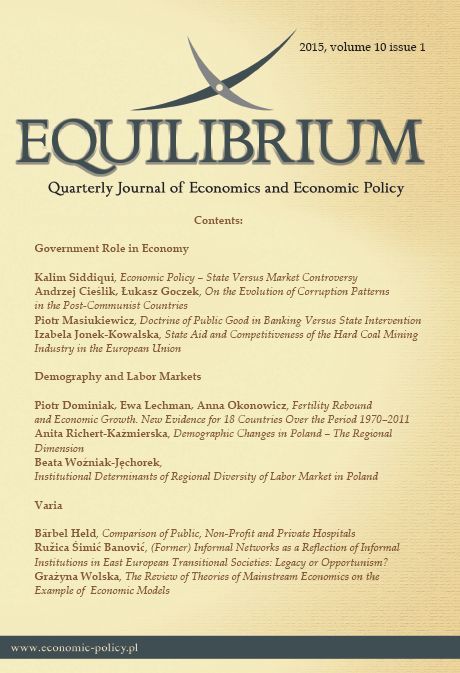On the evolution of corruption patterns in the post-communist countries
DOI:
https://doi.org/10.12775/EQUIL.2015.002Keywords:
corruption, Markov transition probability matrix, post-communist countriesAbstract
In this paper, we study the evolution of corruption patterns in 27 post-communist countries during the period 1996-2012 using the Control of Corruption Index and the corruption category Markov transition probability matrix. This method allows us to generate the long-run distribution of corruption among the post-communist countries. Our empirical findings suggest that corruption in the post-communist countries is a very persistent phenomenon that does not change much over time. Several theoretical explanations for such a result are provided.
Downloads
References
Asiedu, E., & Freeman, J. (2009). The Effect of Corruption on Investment Growth: Evidence from Firms in Latin America, Sub-Saharan Africa, and Transition Countries. Review of Development Economics, 13(2). http://dx.doi.org/10.11 11/j.1467-9361.2009.00507.x.
?slund, A. (1999). Law in Russia. East European Constitutional Review, 8(4).
Aslund, A. (2002). Building Capitalism ? The Transformation of the former Soviet Block. Cambridge: Cambridge University Press, http://dx.doi.org/10.1017/cb o9780511528538.
Bardhan, P. (1997). Corruption and development: a review of issues. Journal of Economic Literature. 35. http://dx.doi.org/10.4324/9780203044858.
Boesche, R. (2003). Kautilya's Arthaś?stra on War and Diplomacy in Ancient India. Journal of Military History. 67 (1), http://dx.doi.org/10.135 3/jmh.2003.0006.
Dabrowski, M., Gomulka, S. & Rostowski, J. (2001). Whence reform? A critique of the Stiglitz perspective. Journal of Economic Policy Reform, 4(4). http://dx.doi.org/10.1080/13841280108523423.
Ferri, G. (2004). More Analysis, Better Ratings: Do Rating Agencies Invest Enough in Less Developed Countries. Journal of Applied Economics 7:77?98.
Golden, M. & Picci, L. (2005). Proposal for a New Measure of Corruption: Illustrated with Italian Data. Economics and Politics. 17(1), http://dx.doi.org/10.1 111/j.1468-0343.2005.00146.x.
Goczek, Ł. (2012). Metody ekonometryczne w modelach wzrostu gospodarczego. Gospodarka Narodowa, 10.
Goczek, Ł. (2010). Badanie empiryczne przyczyn korupcji w krajach transformacji. Gospodarka Narodowa, 4.
Goczek, Ł. (2009). Corruption and Social Norms. Ekonomia, 24.
Goczek, Ł. (2007). Skuteczność strategii antykorupcyjnych i przyczyny korupcji: przegląd literatury empirycznej. Gospodarka Narodowa, 4.
Hellman, J., & Kaufmann, D. (2004). The Inequality of Influence. In: J. Kornai & S. Rose-Ackerman (Eds.). Building a Trustworthy State in Post-Socialist Transition, New York: Palgrave, http://dx.doi.org/10.2139/ssrn.386901.
Hellman, J., & Schankerman, M. (2000). Intervention, Corruption and Capture: The Nexus between Enterprises and the State. Economics of Transition, 8(3). http://dx.doi.org/10.1111/1468-0351.00055.
Hellman, J., Jones G., Kaufmann, D. & Schankerman, M. (1999). Measuring governance, corruption and state capture. World Bank Policy Research Working Paper, no. 2312. http://dx.doi.org/10.1596/1813-9450-2312.
Hellman, J., Jones, G., & Kaufmann, D. (2003). Seize the State, Seize the Day?: State Capture, Corruption, and Influence in Transition. Journal of Comparative Economics, 31.
Henderson, J. V., & Kuncoro, A. (2004). Corruption in Indonesia. NBER Working Paper No. 10674.
Hoff., K, & Stiglitz, J. (2004). After the Big Bang? Obstacles to the Emergence of the Rule of Law in Post-Communist Societies. American Economic Review, 94(3). http://dx.doi.org/10.1257/0002828041464533.
Jain, A. (2001). Corruption: A Review. Journal of Economic Surveys, 15(1).
Jones, Ch. I. (1997). On the Evolution of the World Income Distribution. Journal of Economic Perspectives, 11(3). http://dx.doi.org/10.1257/jep.11.3.19.
Kaufmann, D. (1997).Corruption: The Facts. Foreign Policy, Summer.
Kaufmann, D. (2007). Governace Crossroads: An Empirical Perspective, mimeo
Kaufmann, D., & Kraay, A. (2002). Growth Without Governance. Economia. Fall. Retrieved from: http://www.worldbank.org/wbi/governance/pdf/growthgov.pdf.
Kaufmann, D., & Siegelbaum, P. (1995). Privatisation and Corruption in Transition Economies. Journal of International Affairs, 50(2).
Kaufman, D., & Wei, S. (1999). Does"grease money"speed up the wheels of commerce?. NBER Working Paper No. 7093
Kaufmann, D., Kraay, A., & Mastruzzi, M. (2005). Governance Matters IV: Governance Indicators for 1996?2004. World Bank.
Kaufmann, D., Kraay, A., & Mastruzzi, M. (2006). Governance Matters V: Governance Indicators for 1996-2005. World Bank Policy Research, http://dx.doi.org/10.1596/1813-9450-3630.
Klitgaard, R. (1988). Controlling Corruption. Berkeley: University of California Press.
Kuncoro, A. (2004). Bribery in Indonesia: Some Evidence from Micro-Level Data. Bulletin of Indonesian Economic Studies. 40(3).
Lambsdorff, J. (1998). An Empirical Investigation of Bribery in International Trade. European Journal of Development Research, 10 (1). http://dx.doi.org/10.1080/09578819808426701.
Lambsdorff, J. (2003). How Corruption Affects Persistent Capital Flows. Economics of Governance, 4(3).
Lambsdorff, J. (2004). Framework Document to the 2004 Corruption Perceptions Index. Transparency International Background Paper.
Lambsdorff, J. (2005). Consequences and Causes of Corruption ? What do We Know from a Cross-Section of Countries?. Discussion Paper of the Economics Department, Passau University, No. 34-05
Lambsdorff, J. (2005). Consequences and Causes of Corruption ? What do We Know from a Cross-Section of Countries? Passauer Diskussionspapiere, Nr. V-34-05.
Manzetti, L., & Blake, C. (1996). Market Reforms and Corruption in Latin America. Review of International Political Economy, 3.
Murray-Rust, H., & Velde, V. (1994). Changes in Hydraulic Performance and Comparative Costs of Lining and Desalting of Secondary Canals in Punjab, Pakistan. Irrigation and Drainage Systems, 8(3).
Paldam, M. (2002). The Big Pattern of Corruption. Economics, Culture and the Seesaw Dynamics. European Journal of Political Economy, 18. http://dx.doi.org/10.1016/s0176-2680(02)00078-2.
Sandholtz, W, & Taagepera, R. (2005). Corruption, Culture, and Communism. International Review of Sociology: Revue Internationale de Sociologie, 15(1). http://dx.doi.org/10.1080/03906700500038678.
Stiglitz, E, (1999). Whither Reform: Ten Years of the Transition: Paper Prepared for the Annual World Bank Conference on Development Economics, Washington, D.C., April 28-30.
Svensson, J. (2003). Who Must Pay Bribes and How Much? Evidence from a Cross Section of Firms. Quarterly Journal of Economics, 118. http://dx.doi.org/10.1162/00335530360535180.
Treisman, D. (2000). The Causes of Corruption: A Cross-National Study. Journal of Public Economics, 76(3).
Wade, R. (1982). Irrigation Reform in Conditions of Populist Anarchy: An Indian Case. Journal of Development Economics, 14(3).
World Bank (2006). Anticorruption in Transition 3. Washington, D.C. http://dx.doi.org/10.1596/978-0-8213-6692-9.






